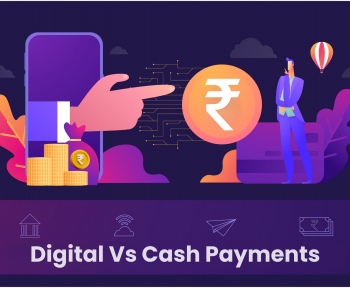Digital financial services are accessed and delivered through a wide array of internet based digital channels such as mobile phones, ATMs, Point of Sale (POS) terminals, laptops, and other electronic devices. They include making payments, remittances, insurance, credit savings, and other financial transactions. The availability of digital financial services has led to a change in the way people manage their finances, especially in low-income and underserved communities, where traditional banking services are scarce.
The rapid adoption of digital technology in day-to-day life has led to customers preferring digital engagements in financial services. Universal access to such services is now within reach, owing to the implementation of transformative business models and ambitious reforms, with technology as the enabler. This is particularly true in developing countries, where financial literacy and digitization initiatives have been well-accepted by the masses. As a result, presently, 80 countries have access to digital financial services, facilitating a sizable global population to move from cash-based transactions to online channels as a medium for their financial transactions. According to a report, around 7.6 billion people worldwide will have a smartphone subscription by the end of 2027. This creates an opportunity for banks and other non-banking financial service providers to reach the financially excluded and underserved population, which previously had limited access to formal financial services.
For billions of people worldwide who lack adequate and easy access to formal financial services, exposure to digital financial services may be transformative. The wide range of benefits that digital financial services offer include:
- Easier access to formal financial services such as payments, money transfers, savings, insurance services, foreign remittances, security exchange, deposit creation etc., are financial services that are possible through digital platforms. As more people develop trust in the digital transactional infrastructure, more account-based services can be accessed online. These include receipt of government money transfers, for example, that facilitate wider financial inclusion in the economic landscape of a country.
- Enhanced quality of service can be achieved by delivering additional services tailored to the individual’s needs, which are possible through the payment, transfer and value storage services embedded in the platform itself.
- Lower costs of transactions are possible for both service providers and customers, as they allow the transactions to occur locally, in irregular or smaller amounts, facilitating the management of uneven income and expenditures. For service providers, the per unit cost is lowered, reducing the overall operational costs.
- Reduced risk of loss due to theft or other crimes, which are possible in cash-based transactions. There is a higher element of safety since digital transactions are encrypted with several security measures to protect the users’ financial data.
- DFS promotes the economic empowerment of women and underserved segments by enabling asset accumulation and savings, increasing their economic participation and financial independence.
- Fast-tracked revenue growth since rapid new customer acquisition becomes possible, in addition to easily delivering products and services enabled by technology.
Types of digital financial services regulated in Indonesia
The financial services industry is one of the most heavily regulated business sectors in any country. This is due to the variety of factors impacting its functioning and its critical role in influencing the country’s economy. The regulations aim to protect both the consumers’ and service providers’ interests, while enabling fair treatment. Digital financial services are also included in the segments that must adhere to applicable laws.
The Financial Services Authority (OJK) and Bank Indonesia (BI) are the two most significant regulatory bodies in Indonesia. Both are tasked with supervising, regulating, and granting permits to businesses in the country. The financial regulators are also aware of the rapid advancements in technology, which make it possible for digital financial service providers to innovate, expand, and create an impact. This also enables businesses to explore new business models and grow, leading to greater financial literacy and inclusion.
Below is a rundown of several types of digital financial services that are regulated in Indonesia.
Digital financial services under Bank Indonesia
- Payment gateways: It allows merchants to process digital payments through various mediums like bank transfers, credit/debit cards, e-money, and virtual accounts. Bank Indonesia is the regulator for all such transactions executed in Indonesia.
- QRIS: Under the regulation of BI, payments via QR codes have been unified under the QRIS – Indonesian Standard Quick Response Code. The QRIS was developed to make the transaction processes easier, faster, and more secure. All payment service providers who previously used QR codes must facilitate QRIS.
- E-money: E-money or electronic money is the value of money electronically stored securely in a chip or a media server, which can be configured to receive payments or transfer funds.
- Wallets: Digital wallets are rapidly becoming Indonesia’s most preferred payment method. They can also save instruments, such as e-money or cards, to facilitate payment. The limit of funds that can be accommodated in an electronic wallet, as per guidelines by BI, is IDR 10 million.
- Fund transfers and remittances: Transfers between banks or payment platforms are registered with BI. There are various mechanisms in place for this, the latest being BI-fast, which allows transactions at a lower fee. Remittances, on the other hand, are fund transfers between parties in different countries. This process can be facilitated by banking or non-banking institutions licensed by Bank Indonesia.
DFS with Financial Services Authority
- Fintech lending: Fintech lending is a digital lending service that uses financial technology to help banks and lending institutions make effective and well-informed business decisions. This is done by leveraging AI, ML and data analytics to assess risk and create lending strategies through statistical insights.
- Digital banks: A digital bank is a legal entity that provides banking services and engages in business activity over online channels, not through a brick-and-mortar branch presence. OJK regulates these establishments.
- Buy-now-pay-later: BNPL schemes are popular in Indonesia. They allow consumers to make online purchases and pay for them in the future. A type of short-term financing service, the scheme allows repayment to be made in lumpsum or installments and is different from fintech lending services that provide cash loans to borrowers. BNPL is presently under the regulation of OJK in Indonesia.
- Crowdfunding: This is a service aimed at raising funds from the public for a defined purpose. Crowdfunding has many applications, such as raising funds for social causes or fundraising for business development or establishment.
Source: Finantier
The emergence of DFS in Indonesia offers significant benefits to the economy, increasing government revenue and job growth. Additionally, the economic impact at national and provincial levels presents the opportunity to introduce the underbanked Indonesian populace into the formal financial system. Financial inclusion facilitated by digital financial services will create new jobs in the economy, improve livelihoods, and have a positive social impact. In order to develop a holistic economy that uses innovation and technology to power growth, it is imperative that DFS providers anticipate and prepare for the gamut of challenges that are intrinsic to a developing economy like Indonesia. Achieving this will require simplifying end-to-end processes such as lending and debt collections, which form the foundation of the fintech sector. Credgenics, a leading SaaS-based debt resolution platform, is empowering banks and financial institutions to leverage technology to optimize collections mechanisms and fast-track scalability.
FAQs:
- Which are the primary financial regulators of digital financial services in Indonesia?
The Financial Services Authority (OJK) and Bank Indonesia (BI) are Indonesia’s two most significant regulatory bodies. Both are responsible for supervising, regulating, and granting permits to businesses in the country. The specific responsibilities of both are predefined. The Financial Services Authority (OJK) is responsible for supervising FinTech lending, digital banks, BNPL schemes, and crowdfunding. Bank Indonesia is responsible for overseeing the functions of payment gateways, QRIS, e-money, wallets, fund transfers, and remittances.
- What constitutes Digital Financial Services?
Digital Financial Services (DFS) comprise of a wide range of financial services accessed and delivered through digital platforms. These services include payments, credit, savings, remittances, and insurance. It also includes mobile financial services. The presence of these services has made it possible for a transition toward digitization. The rapid deployment of technology in daily life is responsible for many products and services being made available on digital platforms.
- How have digital financial services benefited Indonesia?
The main benefits of digital financial services are:
- Access to a wider range of formal financial services and products such as payments, money transfers, savings, financial planning advice, loans, credit cards, insurance services, foreign remittances, security exchange, and deposit creation
- Tailor-made offerings since those products and services can be provided to each customer, which are tailor-made for their individual needs.
- Lower costs of transactions since execution can happen through a digital platform, instead of physically in a brick-and-mortar environment.
- Empowerment and financial inclusion of the underserved and underbanked areas of the country. Since people have more autonomy over their finances, it encourages financial awareness. Additionally, women have more control over their savings, leading to more holistics and all-encompassing development of all segments of demographics.





